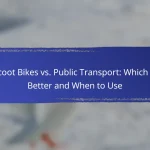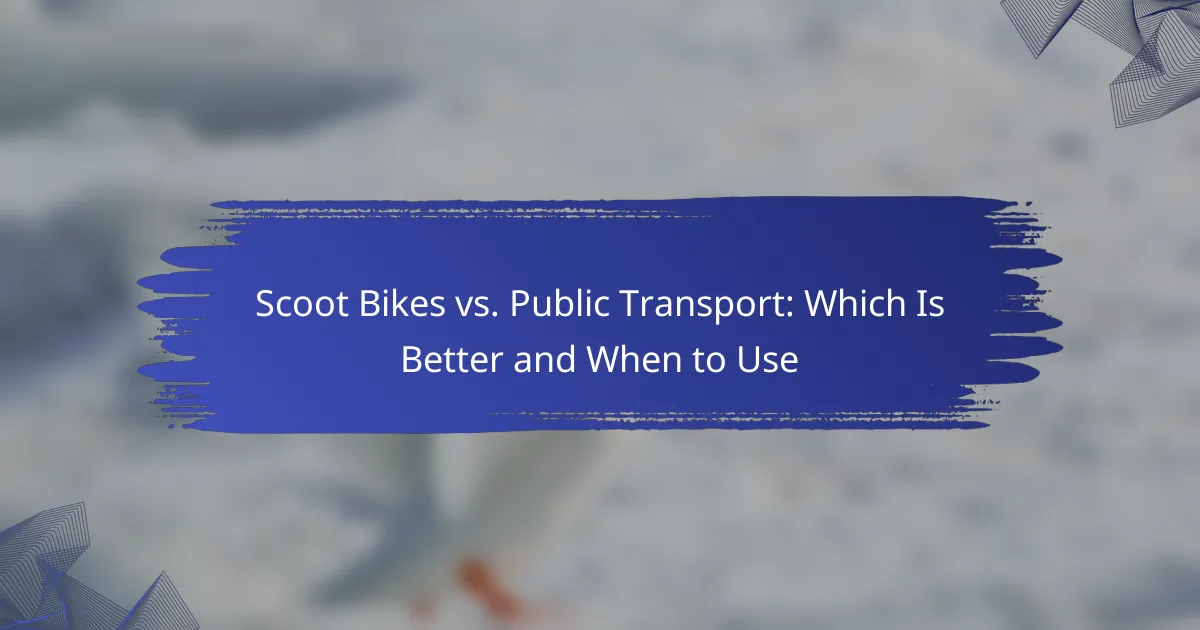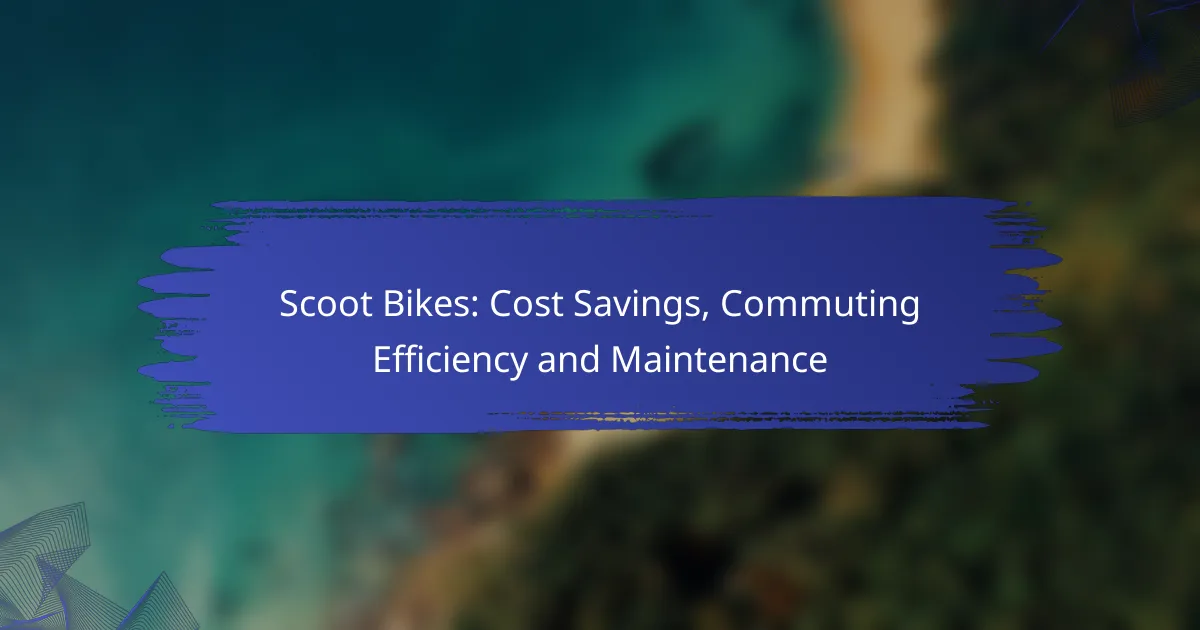When deciding between scoot bikes and public transport, it’s essential to consider the nature of your trip. Scoot bikes provide a quick and flexible option for short distances, making them ideal for those prioritizing speed and convenience. In contrast, public transport remains a reliable choice for longer journeys, offering cost efficiency and a lower environmental impact.

When should you choose scoot bikes over public transport in London?
Scoot bikes are often a better choice than public transport in London for short trips, especially when speed and convenience are priorities. They offer a flexible alternative that can save time and provide a more enjoyable travel experience.
Short-distance travel
Scoot bikes excel in short-distance travel, typically covering distances of up to 5 kilometers efficiently. For trips that would take longer on public transport due to waiting times and transfers, scoot bikes can significantly reduce travel time.
For example, a journey from London Bridge to Borough Market is about 1 kilometer and can be completed in under 10 minutes on a scoot bike, compared to potentially 20 minutes or more using the Tube.
Flexibility and convenience
Scoot bikes provide unmatched flexibility, allowing users to travel at their own pace and choose their routes. Unlike public transport, which operates on fixed schedules and routes, scoot bikes can be picked up and dropped off at various locations throughout the city.
This convenience is particularly beneficial during peak hours when public transport can be crowded and less reliable. Riders can avoid the hassle of navigating busy stations and enjoy a more direct path to their destination.
Cost-effectiveness
Using scoot bikes can be more cost-effective than public transport, especially for frequent short trips. While public transport fares can add up, especially during peak times, many scoot bike services offer affordable pay-as-you-go options or subscription models that can save money.
For instance, a single Tube fare in London can range from £2.40 to £6 depending on the zones, whereas a scoot bike rental might cost around £1 for a short ride, making it a budget-friendly choice for many commuters.
Environmental impact
Scoot bikes have a lower environmental impact compared to public transport, particularly when considering emissions from buses and trains. By choosing to scoot, riders contribute to reduced traffic congestion and lower carbon emissions in the city.
Additionally, many scoot bike services are increasingly using electric bikes, further minimizing their ecological footprint and promoting sustainable urban mobility.
Availability of bike lanes
The availability of bike lanes in London greatly enhances the appeal of scoot bikes. Many areas in the city have dedicated cycling infrastructure, making it safer and more efficient to travel by bike.
Areas like Camden and Hackney have extensive bike lane networks, allowing riders to navigate busy streets with greater ease. However, it’s essential to plan your route to ensure you can take advantage of these lanes and avoid congested areas.

What are the benefits of using public transport in major cities?
Public transport in major cities offers numerous advantages, including cost efficiency, convenience, and reduced environmental impact. It serves as a reliable alternative to personal vehicles, especially for commuting over longer distances.
Cost savings for long distances
Using public transport can significantly reduce travel costs, especially for long distances. For instance, a train or bus ticket may cost a fraction of what you would spend on fuel, parking, and maintenance for a car. In many cities, monthly passes can further lower expenses, often providing unlimited travel for a set fee.
Consider that public transport fares typically range from a few dollars to around $10 for longer journeys, while car expenses can quickly accumulate, often exceeding $50 or more for similar trips when factoring in all costs.
Access to extensive networks
Public transport systems often provide extensive networks that cover large urban areas, making it easier to reach various destinations. Buses, trams, and trains connect neighborhoods, business districts, and major attractions, allowing for seamless travel without the need for a personal vehicle.
This accessibility is particularly beneficial in cities where traffic congestion is common, as public transport can offer direct routes that bypass heavy traffic, saving time and hassle.
Reduced traffic congestion
By using public transport, individuals contribute to reducing traffic congestion in major cities. Fewer cars on the road lead to less gridlock, which benefits everyone by improving travel times and reducing air pollution.
For example, a single bus can replace dozens of cars, significantly decreasing the number of vehicles on the road during peak hours. This shift not only enhances the efficiency of the transport system but also promotes a cleaner urban environment.
Safety and security
Public transport systems often have safety measures in place, including surveillance cameras, well-lit stations, and trained personnel. These features can enhance the sense of security for passengers compared to traveling alone in a car, especially at night.
Moreover, public transport is statistically safer than personal vehicles, with lower rates of accidents per mile traveled. This makes it a reliable option for daily commutes and late-night travel, particularly in urban settings where traffic accidents are more common.

How do scoot bikes compare to public transport in terms of cost?
Scoot bikes generally offer a flexible and often cost-effective alternative to public transport, especially for short distances. However, the overall cost-effectiveness can vary based on factors such as rental fees, duration of use, and public transport fare structures.
Average costs of scoot bike rentals
The average cost of renting a scoot bike typically ranges from a few cents to a couple of dollars per minute, depending on the provider and location. Many services also offer daily or monthly subscriptions that can significantly reduce the per-ride cost for frequent users.
For example, a standard rental might cost around $1 to unlock and then $0.15 per minute. This can add up quickly for longer rides, so it’s essential to calculate the total cost based on your intended usage.
Public transport fare structures
Public transport fares vary widely by city and service type, often structured as single-ride tickets, day passes, or monthly subscriptions. In many urban areas, a single ride can cost between $2 to $3, while day passes may range from $5 to $10, allowing unlimited travel for a set period.
Some cities also offer discounts for students, seniors, or low-income riders, which can make public transport more affordable for certain demographics. It’s important to check local transit authority websites for specific fare details and available discounts.
Cost comparisons for daily commutes
When comparing costs for daily commutes, scoot bikes can be more economical for short distances, especially if you plan to ride multiple times a day. For instance, a daily scoot bike rental for commuting might total around $10 to $20, depending on usage.
In contrast, a daily public transport pass may cost about $5 to $10, making it a better option for longer distances or multiple transfers. Evaluating your specific route and frequency of travel will help determine which option is more cost-effective for your needs.

What factors should you consider when choosing between scoot bikes and public transport?
When deciding between scoot bikes and public transport, consider factors like travel distance, time efficiency, weather conditions, and personal fitness level. Each of these elements can significantly influence your choice based on your specific needs and circumstances.
Travel distance
Travel distance is a crucial factor in determining whether to use a scoot bike or public transport. Scoot bikes are typically more suitable for shorter distances, often under 5 kilometers, where the time spent riding can be comparable to waiting for and riding public transport. For longer distances, public transport may be more efficient, especially in urban areas with extensive networks.
Consider the availability of bike lanes and the safety of the route when choosing a scoot bike. If the distance exceeds 10 kilometers, public transport may offer a more comfortable and less strenuous option.
Time efficiency
Time efficiency varies widely between scoot bikes and public transport depending on the route and traffic conditions. Scoot bikes can save time in congested areas where public transport may face delays. However, if public transport has a direct route with minimal stops, it can be faster for longer journeys.
Evaluate the total time required for each option, including waiting times for public transport and the time needed to park or lock a scoot bike. A quick comparison can help you choose the most efficient mode for your trip.
Weather conditions
Weather conditions play a significant role in your choice between scoot bikes and public transport. Rain, snow, or extreme temperatures can make riding a scoot bike uncomfortable or unsafe. In such cases, public transport is often the better option, providing shelter and a more stable environment.
Check the weather forecast before your journey. If conditions are unfavorable, opting for public transport can save you from an unpleasant experience and ensure you arrive at your destination dry and comfortable.
Personal fitness level
Your personal fitness level is an important consideration when choosing between scoot bikes and public transport. Riding a scoot bike requires a certain level of physical fitness, especially for longer distances or hilly terrain. If you are not accustomed to physical activity, public transport may be the more suitable choice.
Assess your comfort with cycling and your overall health. If you enjoy biking and are in good shape, scoot bikes can be a fun and efficient way to travel. Conversely, if you prefer a more relaxed journey, public transport will likely be more enjoyable.









